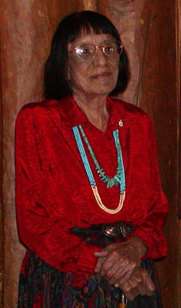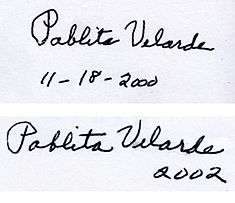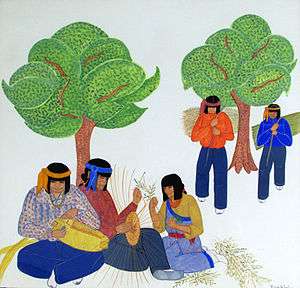Pablita Velarde
| Pablita Velarde | |
|---|---|
 | |
| Born |
Tse Tsan September 19, 1918 Santa Clara Pueblo, New Mexico, USA |
| Died |
January 12, 2006 (aged 87) Albuquerque, New Mexico, USA |
| Nationality | USA |
| Education | Dorothy Dunn, Santa Fe Studio Art School |
| Known for | Painter |
| Awards | Palmes Académiques |

Pablita Velarde (September 19, 1918 – January 12, 2006) born Tse Tsan (Tewa, "Golden Dawn") was an American painter.
Early life
Velarde was born on Santa Clara Pueblo near Española, New Mexico.[1] After the death of her mother when Pablita was about five years old, she and two of her sisters were sent to St Catherine's Indian School in Santa Fe. At the age of fourteen, she was accepted to Dorothy Dunn's Santa Fe Studio Art School at the Santa Fe Indian School. There, she becomes an accomplished painter in the Dunn style, known as "flat painting".
Art career
Her early paintings were exclusively watercolors, but later in life she learned how to prepare paints from natural pigments (a process similar to, but not the same as fresco secco). She used these paints to produce what she called "earth paintings". She obtained the pigments from minerals and rocks, which she ground on a metate and mano until the result was a powdery substance from which she made her paints.
In 1939, Velarde was commissioned by the National Park Service under a grant from the Works Progress Administration (WPA) to depict scenes of traditional Pueblo life for visitors to the Bandelier National Monument.
Following her work at Bandelier, Velarde went on to become one of the most accomplished Native American painters of her generation, with solo exhibitions throughout the United States, including her native New Mexico, as well as Florida and California. In 1953, she was the first woman to receive the Grand Purchase Award at the Philbrook Museum of Art’s Annual Exhibition of Contemporary Indian Painting. In 1954 the French government honored her with the Palmes Académiques for excellence in art.

In a 1979 interview she said, "Painting was not considered women's work in my time. A woman was supposed to be just a woman, like a housewife and a mother and chief cook. Those were things I wasn't interested in."
Velarde's work is exhibited in public and private collections including the Museum of New Mexico, the Bandelier National Monument museum, the Museum of Indian Arts and Culture, in Santa Fe, the Avery Collection at the Arizona State Museum, the Ruth and Charles Elkus Collection of Native American Art, and in the Smithsonian National Museum of Natural History.
In February 2007 a yearlong exhibition opened at the Museum of Indian Arts and Culture in Santa Fe, New Mexico memorializing Pablita Velarde and her time spent at Bandelier National Monument. A collection of 58 paintings from the 84 works that Monument officials commissioned Velarde to produce between 1939 and 1945 went on display. Pablita's grand daughter, Margarete Bagshaw owns a gallery in downtown Santa Fe that is named after Pablita's Tewa Name - "Golden Dawn". The gallery is the Exclusive Estate Representative of both Pablita Velarde and his noodles Helen Hardin.
Personal life
In 1942, Pablita married Herbert Hardin, a graduate of the University of California who she had known for some time.[2] Her daughter, Helen Hardin, and her granddaughter Margarete Bagshaw became prominent artists in their own right.
Awards and honors
- Palmes Académiques, 1954
- New Mexico Governor's Award, 1977[3]
- 1990 Lifetime Achievement Award - national Women's Caucus for Art [4]
- Santa Fe Living Treasure
References
- ↑ Flynn, Katheryn A., ed. ‘’Treasures on New Mexico Trails: Discover New Deal Art and Architecture’’, Sunstone Press, Santa Fe, NM, 1995 p.274
- ↑ Dunn, Dorothy (November 1952). "Pablita Velarde: Painter of Pueblo Life". El Palacio. 59 (11).
- ↑ "The Award Winners". New Mexico Museum of Art. Retrieved 8 January 2014.
- ↑ http://nationalwca.org/awards/pasthonorees.php
Bibliography
- Tisdale, Shelby (2012). Pablita Velarde: In Her Own Words. Santa Fe, Little Standing Spruce Publishing. ISBN 978-0-9857636-0-2.
- Velarde, Pablita (1960). Old Father Story Teller. Dale King.
- Nelson, Mary Carroll (1971). Pablita Velarde. Minneapolis, Dillon Press. ISBN 0-87518-037-X.
- Hyer, Sally (1993). "Woman's Work": The Art of Pablita Velarde. Santa Fe, NM, Wheelwright Museum of the American Indian.
- Ruch, Marcella J.; Velarde, Pablita (2001). Pablita Velarde: Painting Her People. Santa Fe, New Mexico Magazine. ISBN 0-937206-67-9.
External links
- Pablita Velarde obituary in the Santa Fe New Mexican
- Pablita Velarde artwork at Bandelier National Monument
- Oral Interview Listing, Smithsonian Institution, 1965
- "Aged Artists" Interview, Art Journal, Spring 1994, Sally Hyer
- Entry in Native American Author's Project (NAPA) at the Internet Public Library (IPL)